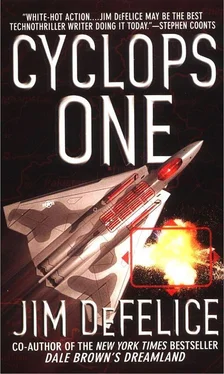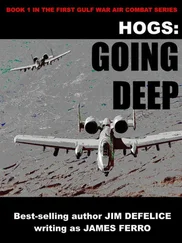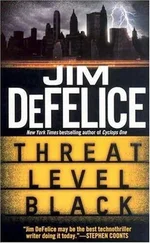The helicopter landed roughly. The pilot said something over the intercom circuit — good luck, maybe — as the ramp door opened. Jalil jumped forward, one of the first men out.
The invaders quickly split themselves into three groups. Jalil went with Corps One, which would take the central approach to the target while the others came in from the flanks. They were running slightly behind schedule; he tapped at his watch as the corps leaders quickly checked their men and then set out. Each corps was subdivided into smaller teams, generally of six or eight men; one member within each team had a night optical device, or NOD, either an infrared or starscope viewer, usually the former. They needed them: It was exceedingly dark tonight, with an uncharacteristic full bank of clouds beneath the moonless sky and the desert.
It took nearly a half hour for them to walk the first kilometer. This was far too long. They had only an hour left to get into position to launch the attack.
Jalil worried that their weeks of training were now going against them; perhaps the men were too tired tonight to face the task before them. He went to each squad leader and urged him to move faster, waving silently with his hand. They made somewhat better time, reaching the midpoint to the assault within another half hour.
Jalil had the option of attacking the radars from long range with the MILANs; he had a good chance of taking out the dishes from two kilometers and in fact could see the outlines of one now through his infrared NOD. But he had planned a full-scale attack, with its much higher probability of success, and he intended on carrying that plan out. He checked with the other corps leaders; they, too, were making poor progress.
“Run,” he told one of his lieutenants, jogging next to him.
Without answering, the man began to double-time and then lope forward. The others in his squad followed. As Jalil moved to issue the command to another of his men, that squad also broke into a trot.
They reached their final staging area thirty seconds late. Jalil thought it prudent to rest them all an additional five minutes before passing the word to begin.
Eight groups of men began moving forward, two holding back in reserve. The two squads in the middle stopped after they had gone about a hundred meters; their targets loomed before them, less than a half-kilometer away. Jalil stayed with these men until he was sure that their missiles were properly prepared and aimed, with each of the two radar dishes and its attendant operator van zeroed in by not one but two missiles. When he was satisfied, Jalil radioed the other groups. Corps Two on his right was just getting into position, but Corps Three was still at least ten minutes from its launch point, and probably more. That was a bad sign: It was the only one of the three groups that had Highway Five in sight, and thus the only one that could stop or even spot potential reinforcements. More important, it was tasked with cutting one of the two land lines from the complex.
Jalil urged the lieutenant in charge to move faster, then handed the radio handset to his communications specialist and turned his attention back to his own men, waiting in the shadows a few hundred meters ahead.
The attack had to be launched in twelve minutes. The plans, carefully coordinated with the Indian Air Force, provided exactly a two-minute window to take out both radar dishes, the transmission towers, and the land lines, isolating the early-warning facility. At the end of that window, the first wave of attack jets would pass overhead, spreading out through the radarless corridor Jalil and his men had provided to launch a preemptive strike against Pakistan’s nuclear force.
The planes were undoubtedly already en route. The lives of their pilots counted on his success.
The men tasked to blow up the transmission towers reported in. There was no one guarding the approach; the charges would be prepared shortly.
No one guarding them?
Suspicion jabbed Jalil. Their intelligence people had predicted lax security — the Pakistanis were famously lazy — but this seemed unbelievable.
Unbelievable!
Jalil’s communications specialist tugged his sleeve. Jalil saw one of his sergeants pointing in the distance, then heard the truck he was alerting him to.
A patrol, heading in their direction.
Jalil pulled up his night glasses. It was an American Humvee, undoubtedly one of the vehicles left to the Muslim devils when they had deceived the superpower into thinking they would fight against the terrorists in Afghanistan. There was a weapon on the back; an antitank gun, he assumed.
They would have night-vision gear as well, though they probably lacked the IQs to use it properly.
The Hummer passed by his team and continued onward, oblivious.
Jalil gave the order for the attack to begin. Two of the three radio towers crumbled simultaneously, the explosions sounding like a stack of chairs falling in a banquet hall. The third fell a second later, but the sound was drowned out by the short screech of a banshee as the first MILAN missile plowed into one of the radar vans.
Then hell opened her mouth and fire spit into the desert. The great god Shiva, the destroyer, hurled his bolts into the Muslims’ early-warning system, obliterating it. Two heavy machine guns, lugged from the helicopter, began cutting down the three Pakistanis foolish enough to emerge from one of the personnel trailers.
A second later the trailer caught fire. Jalil put down his night device and watched as a pair of tiny flames emerged from the larger ones, spit falling from a mouth. They ran a few feet and then collapsed. He thought again of his mother and remained unsatisfied.
“Send the word to the planes,” he told his communications man. “Destroyer has struck. The path is clear.”
“Done,” said the como specialist.
Jalil relaxed. The live-fire simulation was over. They could rest now. The next time they did this, it would be for real.
Fisher watched the video again, studying the white lines. The lines were virtual contrails — computer-generated plots of changes in the atmospheric temperature and composition of the air due to aircraft engines. Below each was a green data log indicating what aircraft had made the track.
There were a few dotted lines — places where the radar had temporarily lost the input or, more likely, the expert explained, places where the records had gotten blurred for various reasons. The storm system had greatly complicated the process; the team responsible for the data — Air Force personnel and two satellite-radar experts from Raytheon — kept cautioning that they had only a 95 percent degree of certainty that they had everything. But everything they had was accounted for.
Fisher scrolled the display upward to the area covering the territory where the Russian spy plane had been tracked. “He’s there before the test?”
“Absolutely,” said the scientist at the keyboard, Tom Peters. He’d brought his CD-ROMs to one of the ancillary labs to go over the data with Fisher; they were the only ones there. “Flying those loops.”
Fisher nodded. The NSA data showed that the spy plane flights had been going on for several weeks on an irregular pattern, not always coinciding with the tests at North Lake.
The techies told him there was no way the Russians could have caused the malfunction. Fisher was inclined to believe them, except that they couldn’t come up with a reasonable explanation for the malfunction.
But one conundrum at a time. He scrolled back to the area where the accident had occurred.
“So, if there was another plane here, like really close to these guys while they’re in the test area, we’d see it?” Fisher asked Peters.
Читать дальше












